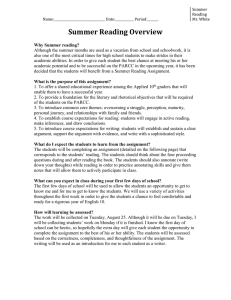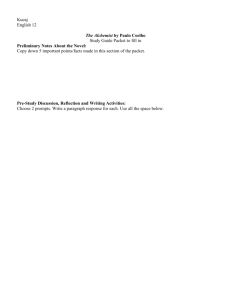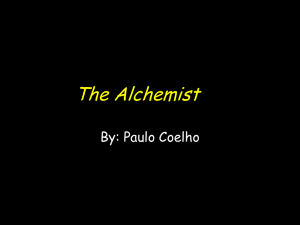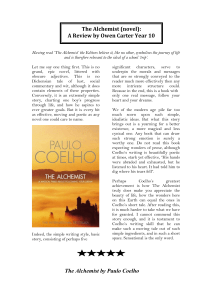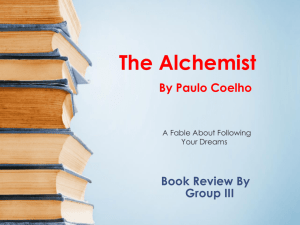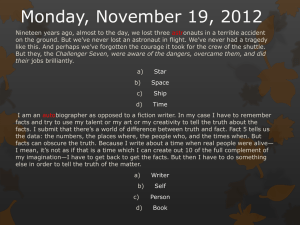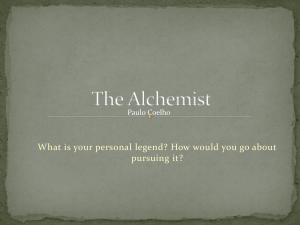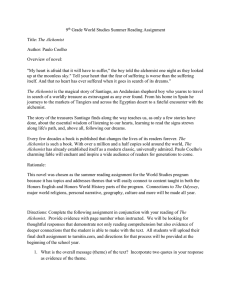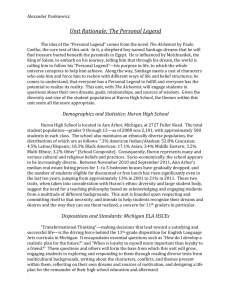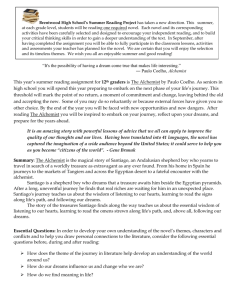File
advertisement
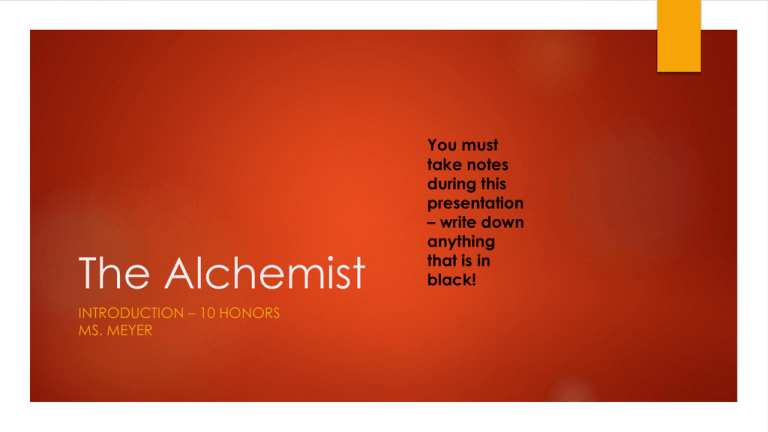
The Alchemist INTRODUCTION – 10 HONORS MS. MEYER You must take notes during this presentation – write down anything that is in black! Bell Ringer What is your personal legend? How would you go about pursuing it? Write a one-paragraph response. I will check this for a classwork grade! What is alchemy? Alchemy: [al-kuh-mee] -noun, plural -mies for 2. 1. a form of chemistry and speculative philosophy practiced in the Middle Ages and the Renaissance and concerned principally with discovering methods for transmuting baser metals into gold and with finding a universal solvent and an elixir of life. 2. any magical power or process of transmuting a common substance, usually of little value, into a substance of great value. So an alchemist … a person who studies or practices alchemy First known use of word 14th century Why read this book? This has been a global bestseller. It’s incredibly popular. This is mostly because it’s a philosophical work that speaks to most people. What does that mean?!?! Here’s what this guy has to say about this novel … https://www.youtube.com/watch?v=dH0IVh5YOLY The Author – Paulo Coelho Biography Paulo Coelho has led an extremely interesting life. Rebelliousness defined his youth. He was a hippie. He wrote popular lyrics for some of Brazil's most famous pop music stars, including Elis Regina and Raul Seixas. Shortly after, he worked as a journalist. In 1986 Paulo Coelho walked the Road to Santiago, a medieval pilgrim's route between France and Spain. He later described this experience in The Pilgrimage, published in 1987. The following year, his second book The Alchemist (1988) established his worldwide fame. Structure The book is divided into the following: The introduction - by the author, explains meaning of the book and author’s thoughts The prologue - introduces the alchemist and tells a new version of the Greek story of Narcissus Part One – the boy realizes his personal legend and grows as a character. Part Two – The end of the boy’s journey. Includes an epiphany. NOTE: Each “part” uses stars (***) to break up the text. There are 12 in part one and 29 in part two. They indicate a change of pace or subject. Epilogue – Sums of the boy’s journey. Structure Continued The Alchemist is written in a fable format. Generally speaking, fables use recognizable, simple characters and settings in order to illustrate a simple truth about life or human nature. Fable - a short tale to teach a moral lesson, often with animals or inanimate objects as characters This is a novel about how the journey matters more than the destination. Can you think of proverbs, songs, or folk tales that express this idea? Point of View This book is set up to feel like a story is being told to the reader. While the boy Santiago is the protagonist, and the story is about him, it is told by an omniscient narrator who is able to give insights into the personal growth of the boy. The narrator makes many statements about life and love, religion and destiny, and therefore gives the impression of the divine. Setting Because the nature of this book is journey-based, the setting changes throughout the boy’s travels. However, in general the setting is the path from southern Spain to the pyramids in Egypt. Themes (we’ll analyze these as we read) This is a bildungsroman – (novel of growth – coming of age story). The major purpose is the intellectual, moral, and spiritual development of a young protagonist. Examples? Self discovery is a journey. Charity is a universal language. Fate is consistently intertwined with free will. Themes The novel integrates ideas and philosophies of many faiths and historical periods. Many of these ideas concern the pursuit of truth, one’s intended destiny and the attainment of personal happiness. Coelho refers to these combined elements as one’s “Personal Legend.” He tells the story of Santiago in order to teach us how we may find and live out our own Personal Legends. The Four Pillars of Alchemy – tips for finding one’s Personal Legend. 1. One must believe in “The Soul of the World.” The ancient Latin term for this concept is “anima mundi.” In short, this idea suggests that everything in the world is interconnected; that is, what one does affects everything else, from the smallest grain of sand to the largest whale, and vice versa. Writers and thinkers such as Plato, Walt Whitman and Khalil Ghibran have attempted to illustrate this interconnectedness in their works. 2. One must listen to the voice of the heart. Coelho suggests that sometimes we must follow our feelings and intuitions, even if we do not fully understand them. Through feeling one gains wisdom. 3. One must be faithful to one’s dreams, for they both test and reward us. In other words, the path to achieving one’s Personal Legend may not be an easy one, but we must endure the tests in order to gain the rewards. 4. One must “surrender oneself to the universe.” Coelho suggests that we must allow ourselves to be open to recognizing and learning from omens and signs which come our way. Remember! There will be a quiz on this information NEXT class! Short answer and MC. Study! Introduction WebQuest – Due @ at the end of the block You will complete a Webquest to introduce the novel. You may work with ONE partner or work individually. We have 20 laptops, but you may use your devices, and the two desktops in the room. YOU MUST INCLUDE THE URL/WEBSITE INFORMATION FOR YOUR SOURCES. Answer in complete sentences. You may turn in one sheet for both of you if you are working with a partner. HW: Read ONLY the introduction and prologue.
